Reconfigurable Terahertz Metamaterials Based on the Refractive Index Change of Epitaxial Vanadium Dioxide Films Across the Metal–Insulator Transition
Abstract
1. Introduction
2. Fabrication and Characterization
3. Results and Discussion
3.1. Simulations for Transmission Spectra
3.2. ASSR/VO2 Spectra Influenced by Conductivity Change
3.3. Experimental Results
3.4. THz Properties of VO2 Film
3.5. THz Properties Influenced by Percolation Effect
3.6. Microscopic Origin of Dielectric Window
4. Conclusions
Supplementary Materials
Author Contributions
Funding
Data Availability Statement
Conflicts of Interest
References
- Tan, L.; Wang, D.; Xu, K.-D. Terahertz metamaterials for spectrum modulation: Structural design, materials and applications. Mater. Des. 2024, 244, 113217. [Google Scholar] [CrossRef]
- Li, C.; Pan, R.; Gu, C.; Guo, H.; Li, J. Reconfigurable Micro/Nano-Optical Devices Based on Phase Transitions: From Materials, Mechanisms to Applications. Adv. Sci. 2024, 11, 2306344. [Google Scholar] [CrossRef]
- Wang, R.; Xu, L.; Huang, L.; Zhang, X.; Ruan, H.; Yang, X.; Lou, J.; Chang, C.; Du, X. Ultrasensitive Terahertz Biodetection Enabled by Quasi-BIC-Based Metasensors. Small 2023, 19, 2301165. [Google Scholar] [CrossRef]
- Gu, J.; Singh, R.; Liu, X.; Zhang, X.; Ma, Y.; Zhang, S.; Maier, S.A.; Tian, Z.; Azad, A.K.; Chen, H.-T.; et al. Active control of electromagnetically induced transparency analogue in terahertz metamaterials. Nat. Commun. 2012, 3, 1151. [Google Scholar] [CrossRef] [PubMed]
- Yan, X.; Yang, M.; Zhang, Z.; Liang, L.; Wei, D.; Wang, M.; Zhang, M.; Wang, T.; Liu, L.; Xie, J.; et al. The terahertz electromagnetically induced transparency-like metamaterials for sensitive biosensors in the detection of cancer cells. Biosens. Bioelectron. 2019, 126, 485–492. [Google Scholar] [CrossRef]
- Prakash, S.; Pitchappa, P.; Agrawal, P.; Jani, H.; Zhao, Y.; Kumar, A.; Thong, J.; Linke, J.; Ariando, A.; Singh, R.; et al. Electromechanically Reconfigurable Terahertz Stereo Metasurfaces. Adv. Mater. 2024, 36, 2402069. [Google Scholar] [CrossRef]
- Jeong, Y.-G.; Bahk, Y.-M.; Kim, D.-S. Dynamic Terahertz Plasmonics Enabled by Phase-Change Materials. Adv. Opt. Mater. 2020, 8, 1900548. [Google Scholar] [CrossRef]
- Gray, A.X.; Hoffmann, M.C.; Jeong, J.; Aetukuri, N.P.; Zhu, D.; Hwang, H.Y.; Brandt, N.C.; Wen, H.; Sternbach, A.J.; Bonetti, S.; et al. Ultrafast terahertz field control of electronic and structural interactions in vanadium dioxide. Phys. Rev. B 2018, 98, 045104. [Google Scholar] [CrossRef]
- Thompson, Z.J.; Stickel, A.; Jeong, Y.-G.; Han, S.; Son, B.H.; Paul, M.J.; Lee, B.; Mousavian, A.; Seo, G.; Kim, H.-T.; et al. Terahertz-Triggered Phase Transition and Hysteresis Narrowing in a Nanoantenna Patterned Vanadium Dioxide Film. Nano Lett. 2015, 15, 5893–5898. [Google Scholar] [CrossRef]
- Choi, S.B.; Kyoung, J.S.; Kim, H.S.; Park, H.R.; Park, D.J.; Kim, B.-J.; Ahn, Y.H.; Rotermund, F.; Kim, H.-T.; Ahn, K.J.; et al. Nanopattern enabled terahertz all-optical switching on vanadium dioxide thin film. Appl. Phys. Lett. 2011, 98, 071105. [Google Scholar] [CrossRef]
- Zhou, G.; Dai, P.; Wu, J.; Jin, B.; Wen, Q.; Zhu, G.; Shen, Z.; Zhang, C.; Kang, L.; Xu, W.; et al. Broadband and high modulation-depth THz modulator using low bias controlled VO2-integrated metasurface. Opt. Express 2017, 25, 17322–17328. [Google Scholar] [CrossRef] [PubMed]
- Li, G.; Zhou, Q.; Ge, C.; Liang, W.; Deng, Y.; Liu, C.; Zhang, C.; Du, J.; Jin, K.-J. Influence of micro-structure on modulation properties in VO2 composite terahertz memory metamaterials. Opt. Express 2020, 28, 31436–31445. [Google Scholar] [CrossRef] [PubMed]
- Cai, H.; Chen, S.; Zou, C.; Huang, Q.; Liu, Y.; Hu, X.; Fu, Z.; Zhao, Y.; He, H.; Lu, Y. Multifunctional Hybrid Metasurfaces for Dynamic Tuning of Terahertz Waves. Adv. Opt. Mater. 2018, 6, 1800257. [Google Scholar] [CrossRef]
- Wen, T.; Wan, P.; Lu, C.; Zhang, D.; Gao, M.; Lin, Y.; Wen, Q.; Liao, Y.; Zhang, H.; Zhong, Z. Tune the resonance of VO2 joined metamaterial dimers by adjacent cut wires. Opt. Express 2022, 30, 29379–29387. [Google Scholar] [CrossRef] [PubMed]
- Liu, J.; Tan, Y.; Zhang, D.; Wen, Q.; Liao, Y.; Zhong, Z.; Wen, T. Plasmonic Nanocomposite for Active Dielectric Metasurface Terahertz Absorbers. IEEE Trans. Terahertz Sci. Technol. 2023, 13, 381–388. [Google Scholar] [CrossRef]
- Wuttig, M.; Yamada, N. Phase-change materials for rewriteable data storage. Nat. Mater. 2007, 6, 824–832. [Google Scholar] [CrossRef]
- Kowerdziej, R.; Jaroszewicz, L.; Olifierczuk, M.; Parka, J. Experimental study on terahertz metamaterial embedded in nematic liquid crystal. Appl. Phys. Lett. 2015, 106, 092905. [Google Scholar] [CrossRef]
- Piccirillo, B.; Paparo, D.; Rubano, A.; Andreone, A.; Rossetti Conti, M.; Giove, D.; Vicuña-Hernández, V.; Koral, C.; Masullo, M.R.; Mettivier, G.; et al. Liquid Crystal-Based Geometric Phase-Enhanced Platform for Polarization and Wavefront Analysis Techniques with the Short-TeraHertz FEL Oscillator TerRa@BriXSinO. Symmetry 2023, 15, 103. [Google Scholar] [CrossRef]
- Scalari, G.; Maissen, C.; Cibella, S.; Leoni, R.; Carelli, P.; Valmorra, F.; Beck, M.; Faist, J. Superconducting complementary metasurfaces for THz ultrastrong light-matter coupling. New J. Phys. 2014, 16, 033005. [Google Scholar] [CrossRef]
- Liu, H.; Lu, J.; Wang, X.R. Metamaterials based on the phase transition of VO2. Nanotechnology 2018, 29, 024002. [Google Scholar] [CrossRef]
- Zhao, X.G.; Duan, G.W.; Li, A.B.; Chen, C.X.; Zhang, X. Integrating microsystems with metamaterials towards metadevices. Microsyst. Nanoeng. 2019, 5, 5. [Google Scholar] [CrossRef] [PubMed]
- Shaltout, A.M.; Shalaev, V.M.; Brongersma, M.L. Spatiotemporal light control with active metasurfaces. Science 2019, 364, aat3100. [Google Scholar] [CrossRef] [PubMed]
- Ma, Z.T.; Geng, Z.X.; Fan, Z.Y.; Liu, J.; Chen, H.D. Modulators for Terahertz Communication: The Current State of the Art. Research 2019, 2019, 6482975. [Google Scholar] [CrossRef]
- Kim, C.-Y.; Slusar, T.; Cho, J.; Kim, H.-T. Mott Switching and Structural Transition in the Metal Phase of VO2 Nanodomain. ACS Appl. Electron. Mater. 2021, 3, 605–610. [Google Scholar] [CrossRef]
- Kim, H.-T.; Chae, B.-G.; Youn, D.-H.; Maeng, S.-L.; Kim, G.; Kang, K.-Y.; Lim, Y.-S. Mechanism and observation of Mott transition in VO2-based two- and three-terminal devices. New J. Phys. 2004, 6, 52. [Google Scholar] [CrossRef]
- Ji, Y.; Pan, R.; Chen, H.; Zhang, H.; Zhao, R.; Yuan, Y.; Yang, H. Shear strain stabilized high-temperature metallic monoclinic VO2 variants with symmetry permission. Appl. Phys. Lett. 2023, 122, 111603. [Google Scholar] [CrossRef]
- Chen, S.C.; Yuan, H.K.; Zhai, Z.H.; Du, L.H.; Zhong, S.C.; Zhu, H.F.; Shi, Q.W.; Huang, W.X.; Li, Z.R.; Zhu, L.G. All optically driven memory device for terahertz waves. Opt. Lett. 2020, 45, 236–239. [Google Scholar] [CrossRef]
- Zhao, Y.; Zhang, Y.; Shi, Q.; Liang, S.; Huang, W.; Kou, W.; Yang, Z. Dynamic Photoinduced Controlling of the Large Phase Shift of Terahertz Waves via Vanadium Dioxide Coupling Nanostructures. Acs Photonics 2018, 5, 3040–3050. [Google Scholar] [CrossRef]
- Zhu, Y.; Vegesna, S.; Zhao, Y.; Kuryatkov, V.; Holtz, M.; Fan, Z.; Saed, M.; Bernussi, A.A. Tunable dual-band terahertz metamaterial bandpass filters. Opt. Lett. 2013, 38, 2382–2384. [Google Scholar] [CrossRef]
- Ding, F.; Zhong, S.; Bozhevolnyi, S.I. Vanadium Dioxide Integrated Metasurfaces with Switchable Functionalities at Terahertz Frequencies. Adv. Opt. Mater. 2018, 6, 1701204. [Google Scholar] [CrossRef]
- Cocker, T.L.; Titova, L.V.; Fourmaux, S.; Bandulet, H.-C.; Brassard, D.; Kieffer, J.-C.; Khakani, M.A.E.; Hegmann, F.A. Terahertz conductivity of the metal-insulator transition in a nanogranular VO2 film. Appl. Phys. Lett. 2010, 97, 221905. [Google Scholar] [CrossRef]
- Cocker, T.L.; Titova, L.V.; Fourmaux, S.; Holloway, G.; Bandulet, H.C.; Brassard, D.; Kieffer, J.C.; El Khakani, M.A.; Hegmann, F.A. Phase diagram of the ultrafast photoinduced insulator-metal transition in vanadium dioxide. Phys. Rev. B 2012, 85, 155120. [Google Scholar] [CrossRef]
- Ordonez-Miranda, J.; Ezzahri, Y.; Joulain, K.; Drevillon, J.; Alvarado-Gil, J.J. Modeling of the electrical conductivity, thermal conductivity, and specific heat capacity of VO2. Phys. Rev. B 2018, 98, 075144. [Google Scholar] [CrossRef]
- Lu, C.; Gao, M.; Liu, J.; Lu, Y.; Wen, T.; Lin, Y. Separation of terahertz and DC conductivity transitions in epitaxial vanadium dioxide films. J. Appl. Phys. 2024, 135, 225301. [Google Scholar] [CrossRef]
- Kužel, P.; Němec, H. Terahertz Spectroscopy of Nanomaterials: A Close Look at Charge-Carrier Transport. Adv. Opt. Mater. 2019, 8, 1900623. [Google Scholar] [CrossRef]
- Choi, H.S.; Ahn, J.S.; Jung, J.H.; Noh, T.W.; Kim, D.H. Mid-infrared properties of a VO2 film near the metal-insulator transition. Phys. Rev. B 1996, 54, 4621–4628. [Google Scholar] [CrossRef]
- Qazilbash, M.M.; Tripathi, A.; Schafgans, A.A.; Kim, B.-J.; Kim, H.-T.; Cai, Z.; Holt, M.V.; Maser, J.M.; Keilmann, F.; Shpyrko, O.G.; et al. Nanoscale imaging of the electronic and structural transitions in vanadium dioxide. Phys. Rev. B 2011, 83, 165108. [Google Scholar] [CrossRef]
- Vidas, L.; Günther, C.M.; Miller, T.A.; Pfau, B.; Perez-Salinas, D.; Martínez, E.; Schneider, M.; Gührs, E.; Gargiani, P.; Valvidares, M.; et al. Imaging Nanometer Phase Coexistence at Defects During the Insulator–Metal Phase Transformation in VO2 Thin Films by Resonant Soft X-ray Holography. Nano Lett. 2018, 18, 3449–3453. [Google Scholar] [CrossRef]
- Stinson, H.T.; Sternbach, A.; Najera, O.; Jing, R.; McLeod, A.S.; Slusar, T.V.; Mueller, A.; Anderegg, L.; Kim, H.T.; Rozenberg, M.; et al. Imaging the nanoscale phase separation in vanadium dioxide thin films at terahertz frequencies. Nat. Commun. 2018, 9, 3604. [Google Scholar] [CrossRef]
- Qazilbash, M.M.; Brehm, M.; Chae, B.-G.; Ho, P.-C.; Andreev, G.O.; Kim, B.-J.; Yun, S.J.; Balatsky, A.V.; Maple, M.B.; Keilmann, F.; et al. Mott Transition in VO2 Revealed by Infrared Spectroscopy and Nano-Imaging. Science 2007, 318, 1750–1753. [Google Scholar] [CrossRef]
- Fu, D.; Liu, K.; Tao, T.; Lo, K.; Cheng, C.; Liu, B.; Zhang, R.; Bechtel, H.A.; Wu, J. Comprehensive study of the metal-insulator transition in pulsed laser deposited epitaxial VO2 thin films. J. Appl. Phys. 2013, 113, 043707. [Google Scholar] [CrossRef]

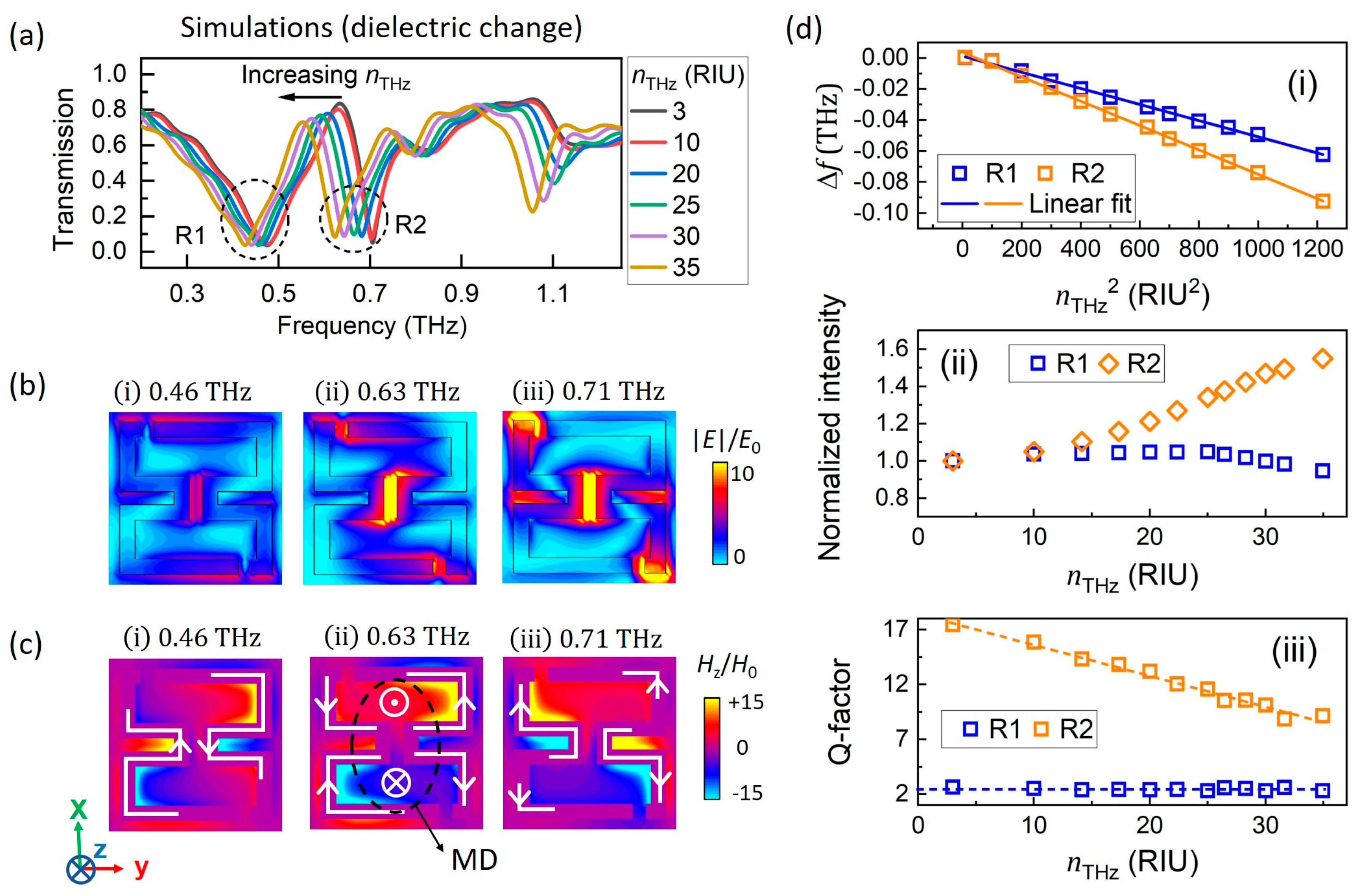
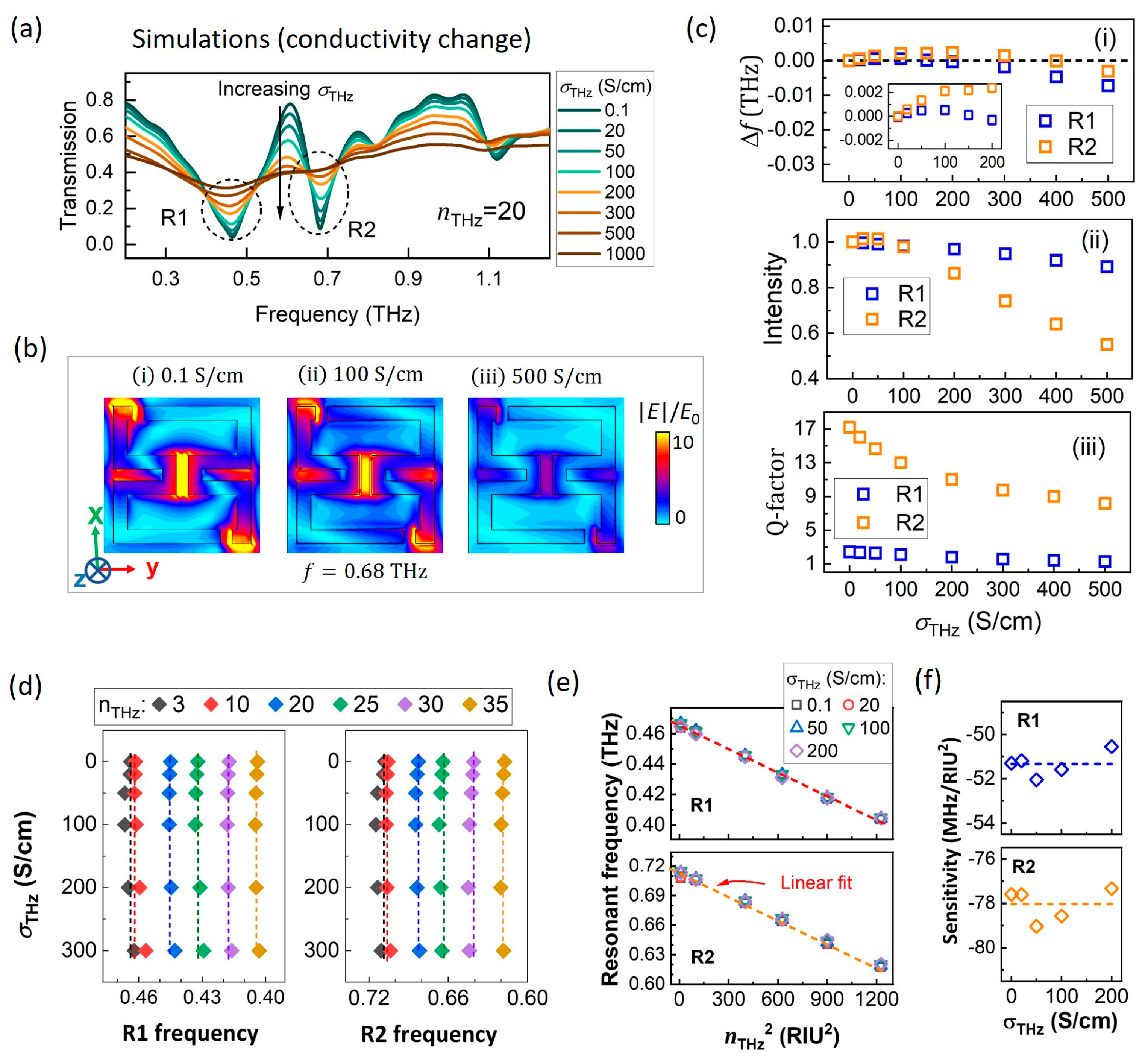
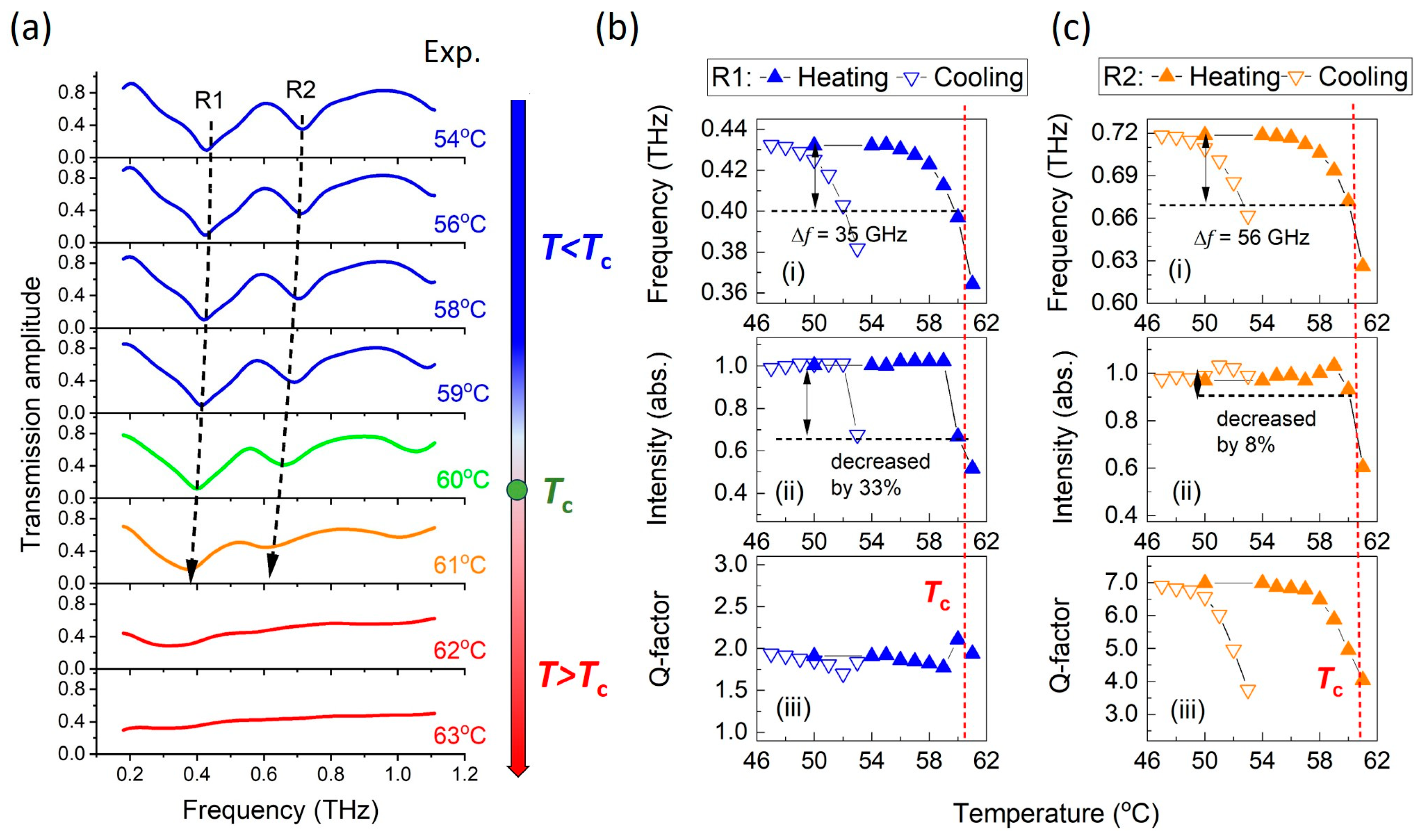
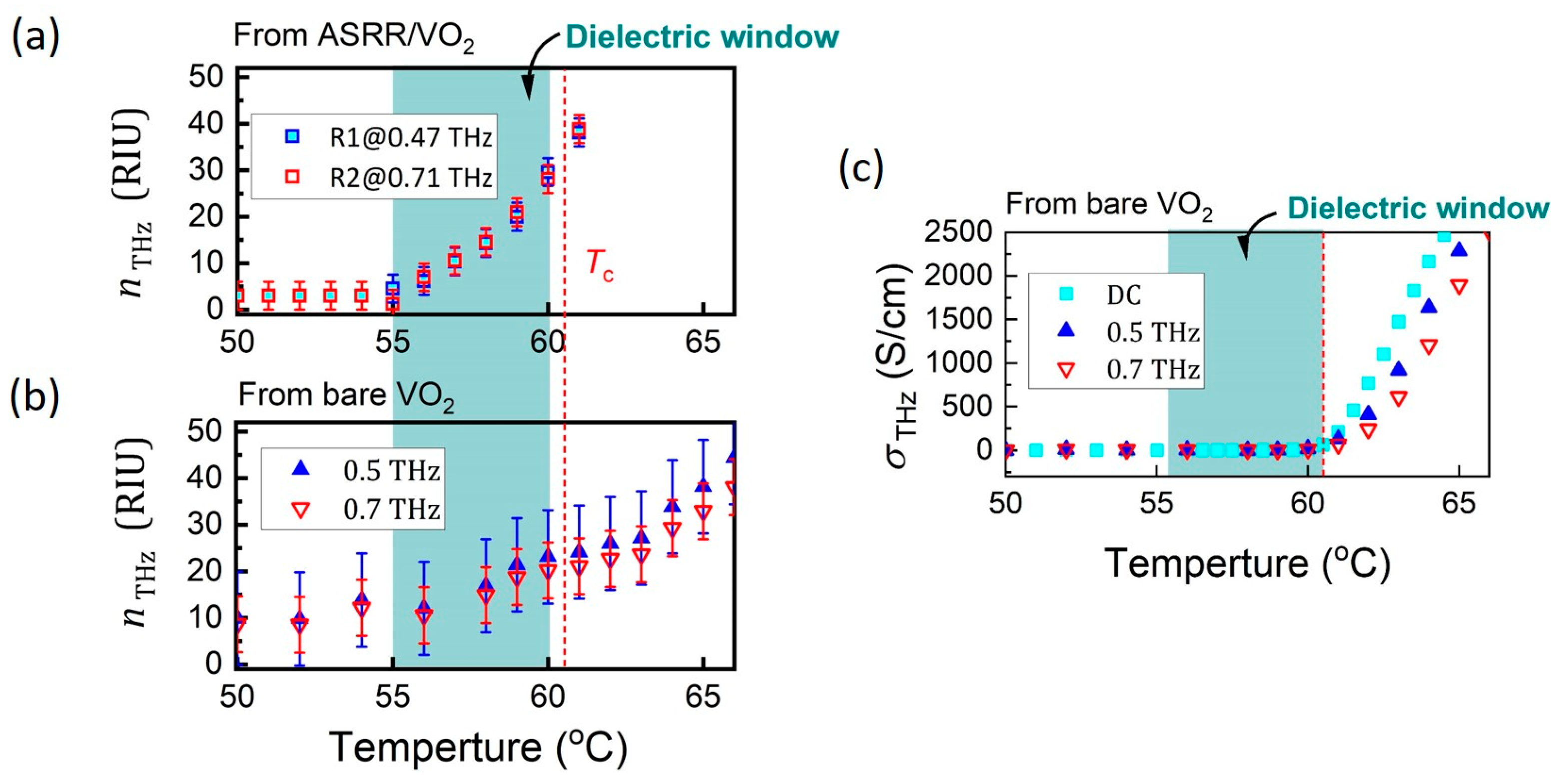
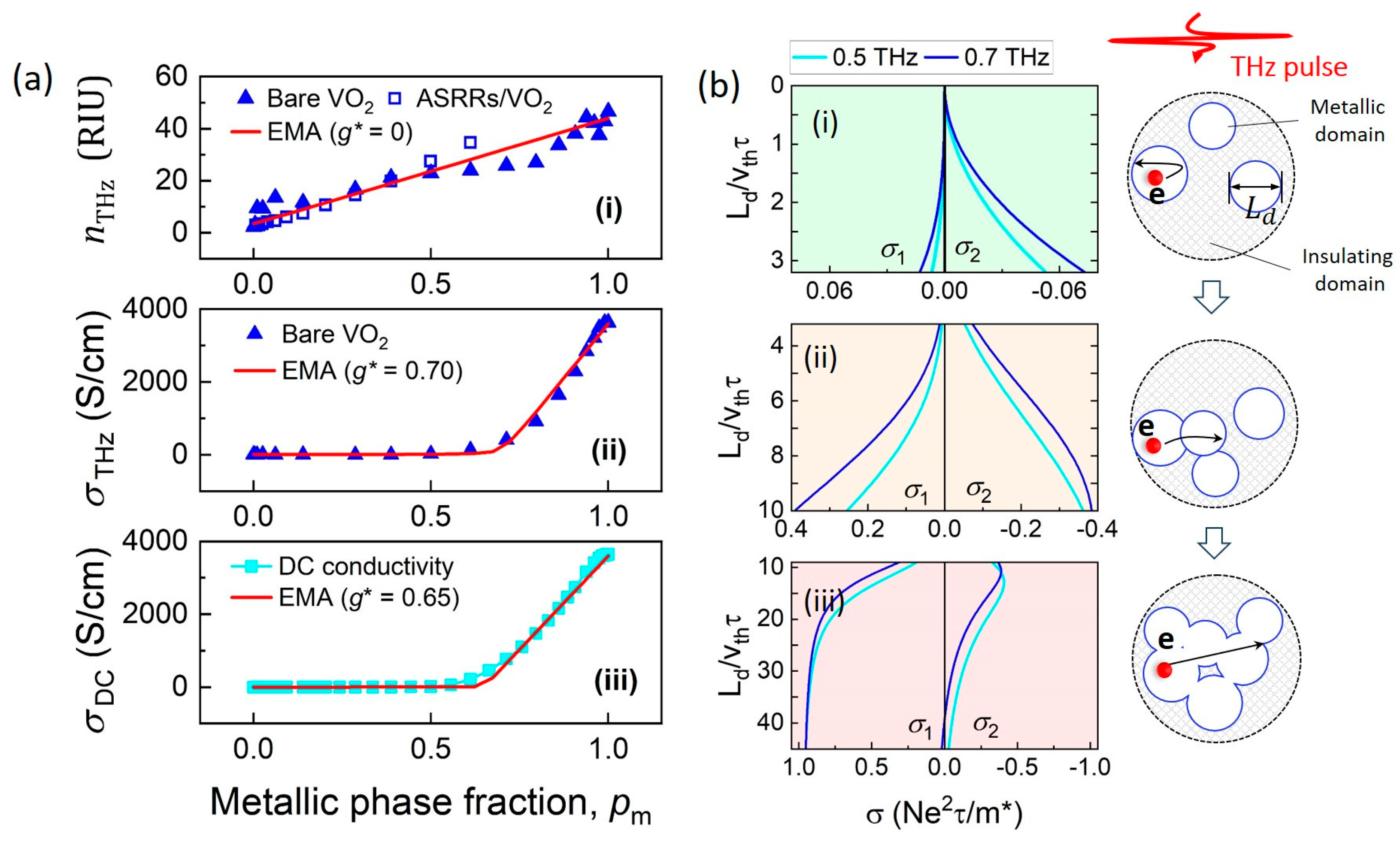
Disclaimer/Publisher’s Note: The statements, opinions and data contained in all publications are solely those of the individual author(s) and contributor(s) and not of MDPI and/or the editor(s). MDPI and/or the editor(s) disclaim responsibility for any injury to people or property resulting from any ideas, methods, instructions or products referred to in the content. |
© 2025 by the authors. Licensee MDPI, Basel, Switzerland. This article is an open access article distributed under the terms and conditions of the Creative Commons Attribution (CC BY) license (https://creativecommons.org/licenses/by/4.0/).
Share and Cite
Lu, C.; Liang, W. Reconfigurable Terahertz Metamaterials Based on the Refractive Index Change of Epitaxial Vanadium Dioxide Films Across the Metal–Insulator Transition. Nanomaterials 2025, 15, 439. https://doi.org/10.3390/nano15060439
Lu C, Liang W. Reconfigurable Terahertz Metamaterials Based on the Refractive Index Change of Epitaxial Vanadium Dioxide Films Across the Metal–Insulator Transition. Nanomaterials. 2025; 15(6):439. https://doi.org/10.3390/nano15060439
Chicago/Turabian StyleLu, Chang, and Weizheng Liang. 2025. "Reconfigurable Terahertz Metamaterials Based on the Refractive Index Change of Epitaxial Vanadium Dioxide Films Across the Metal–Insulator Transition" Nanomaterials 15, no. 6: 439. https://doi.org/10.3390/nano15060439
APA StyleLu, C., & Liang, W. (2025). Reconfigurable Terahertz Metamaterials Based on the Refractive Index Change of Epitaxial Vanadium Dioxide Films Across the Metal–Insulator Transition. Nanomaterials, 15(6), 439. https://doi.org/10.3390/nano15060439






